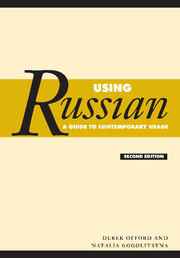Book contents
- Frontmatter
- Contents
- Preface to the first edition
- Preface to the second edition
- Acknowledgements
- Sources
- Note on transcription, stress marks and transliteration
- Glossary of linguistic terms
- List of abbreviations
- 1 Varieties of language and register
- 2 Passages illustrating register
- 3 Problems of meaning: Russian words
- 4 Problems of translation from English into Russian
- 5 Vocabulary and idiom
- 6 Language and everyday life
- 7 Verbal etiquette
- 8 Word-formation
- 9 Inflection
- 10 Prepositions
- 11 Syntax
- 12 Stress
- Index of Russian words, phrases and affixes
- General index
3 - Problems of meaning: Russian words
Published online by Cambridge University Press: 05 June 2012
- Frontmatter
- Contents
- Preface to the first edition
- Preface to the second edition
- Acknowledgements
- Sources
- Note on transcription, stress marks and transliteration
- Glossary of linguistic terms
- List of abbreviations
- 1 Varieties of language and register
- 2 Passages illustrating register
- 3 Problems of meaning: Russian words
- 4 Problems of translation from English into Russian
- 5 Vocabulary and idiom
- 6 Language and everyday life
- 7 Verbal etiquette
- 8 Word-formation
- 9 Inflection
- 10 Prepositions
- 11 Syntax
- 12 Stress
- Index of Russian words, phrases and affixes
- General index
Summary
This chapter lists some of the Russian words that give difficulty to the English-speaking student. The difficulty may arise for any one of several reasons. For example, the Russian word may have a wide range of meaning. It may be easily confused with some other Russian word or words. It may be deceptively similar to some English word. It may occur in a plural form whereas its English equivalent occurs in a singular form or vice versa. Or it may denote some phenomenon or concept that is unfamiliar to an English-speaker.
Homonyms
Homonyms arise in several ways. Firstly, as a result of phonological change a word may come to coincide in sound and form with another word of different origin (as is the case with the pair лук). Secondly, identical forms may develop as a result of the processes of word-formation, by the addition of distinct suffixes to a root (e.g. удáрник). Thirdly, it very often happens that an existing word takes on quite a new meaning (e.g. свет).
We also include here a few words (e.g. ногá) which strictly speaking are not homonyms but which have a range of meaning that is unexpected to English-speakers.
Many of the examples given here are full homonyms (i.e. they have identical pronunciation and paradigms, e.g. ключ in its different meanings), while others are partial homonyms (i.e. they do not share all the forms which each word possesses, e.g. мир, which does not have plural forms in its sense of peace).
- Type
- Chapter
- Information
- Using RussianA Guide to Contemporary Usage, pp. 73 - 97Publisher: Cambridge University PressPrint publication year: 2005



